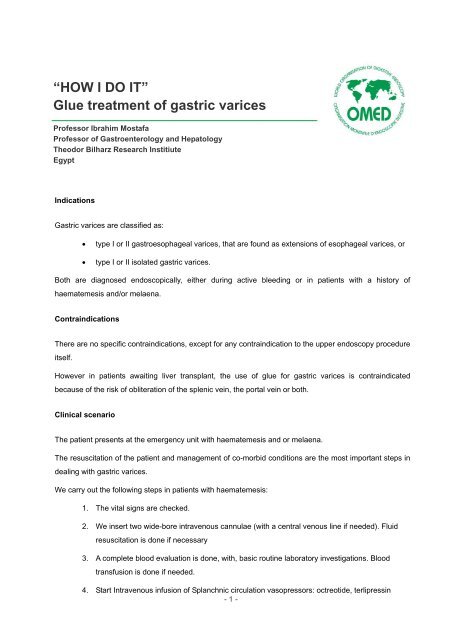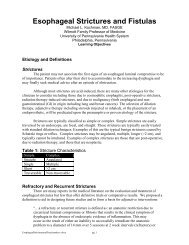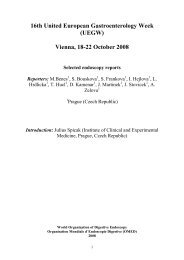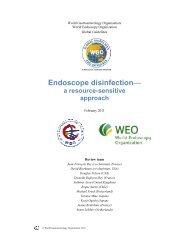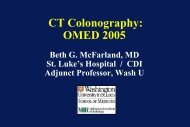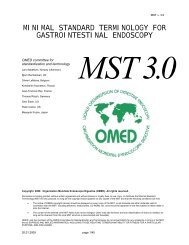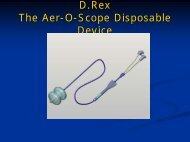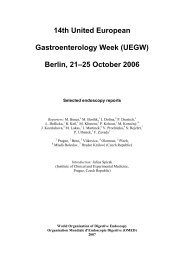âHOW I DO ITâ Glue treatment of gastric varices
âHOW I DO ITâ Glue treatment of gastric varices
âHOW I DO ITâ Glue treatment of gastric varices
Create successful ePaper yourself
Turn your PDF publications into a flip-book with our unique Google optimized e-Paper software.
“HOW I <strong>DO</strong> IT”<br />
<strong>Glue</strong> <strong>treatment</strong> <strong>of</strong> <strong>gastric</strong> <strong>varices</strong><br />
Pr<strong>of</strong>essor Ibrahim Mostafa<br />
Pr<strong>of</strong>essor <strong>of</strong> Gastroenterology and Hepatology<br />
Theodor Bilharz Research Institiute<br />
Egypt<br />
Indications<br />
Gastric <strong>varices</strong> are classified as:<br />
• type I or II gastroesophageal <strong>varices</strong>, that are found as extensions <strong>of</strong> esophageal <strong>varices</strong>, or<br />
• type I or II isolated <strong>gastric</strong> <strong>varices</strong>.<br />
Both are diagnosed endoscopically, either during active bleeding or in patients with a history <strong>of</strong><br />
haematemesis and/or melaena.<br />
Contraindications<br />
There are no specific contraindications, except for any contraindication to the upper endoscopy procedure<br />
itself.<br />
However in patients awaiting liver transplant, the use <strong>of</strong> glue for <strong>gastric</strong> <strong>varices</strong> is contraindicated<br />
because <strong>of</strong> the risk <strong>of</strong> obliteration <strong>of</strong> the splenic vein, the portal vein or both.<br />
Clinical scenario<br />
The patient presents at the emergency unit with haematemesis and or melaena.<br />
The resuscitation <strong>of</strong> the patient and management <strong>of</strong> co-morbid conditions are the most important steps in<br />
dealing with <strong>gastric</strong> <strong>varices</strong>.<br />
We carry out the following steps in patients with haematemesis:<br />
1. The vital signs are checked.<br />
2. We insert two wide-bore intravenous cannulae (with a central venous line if needed). Fluid<br />
resuscitation is done if necessary<br />
3. A complete blood evaluation is done, with, basic routine laboratory investigations. Blood<br />
transfusion is done if needed.<br />
4. Start Intravenous infusion <strong>of</strong> Splanchnic circulation vasopressors: octreotide, terlipressin<br />
- 1 -
5. Proton pump inhibitors (PPIs) are given by continuous intravenous infusion during the first<br />
24 hours<br />
6. A naso<strong>gastric</strong> tube is inserted and <strong>gastric</strong> lavage is done.<br />
7. Endoscopy is done within 6 hours after resuscitation (anytime within 24 hours) as second<br />
episodes <strong>of</strong> haematemesis have a very high mortality rate compared with the first.<br />
Informed consent: Including the risks <strong>of</strong> the procedure<br />
Risks include aspiration, pulmonary embolism very rarely (once in last 20 years), or obliteration <strong>of</strong> the<br />
splenic vein or the portal vein or both.<br />
Sedation used<br />
Diprivan (prop<strong>of</strong>ol) may be used so that the patient is calm while the procedure is performed.<br />
If the patient is in a very critical state, a cuffed endotracheal tube is inserted before the procedure.<br />
I do not use topical anaesthesia.<br />
Equipment used<br />
A prepared endoscope with channel size 2.8 mm or more to allow the passage <strong>of</strong> the injector needle is<br />
needed. Prepared here means sterilized, with the air supply connected and tested, and the suction<br />
function connected and tested.<br />
Accessories used<br />
• 21-gauge injection needles. A minimum <strong>of</strong> five needles must be ready in the endoscopy room, as<br />
the needle is usually blocked after the first injection.<br />
• 23-gauge injection needles for esophageal <strong>varices</strong><br />
• Band ligation sets for esophageal <strong>varices</strong><br />
• All accessories used in the management <strong>of</strong> nonvariceal bleeding, such as argon plasma<br />
coagulation (APC) equipment, hemoclips, epinephrine, thermal coagulation equipment, etc, must be<br />
ready for use in the endoscopy room.<br />
Injection fluids<br />
These fluids are required:<br />
• Histoacryl (n-butyl cyanoacrylate) 0.5 ml per ampoule<br />
• Lipiodol solution<br />
- 2 -
• Distilled water.<br />
The mixture <strong>of</strong> Histoacryl and lipiodol should be prepared before the procedure in patients with suspicion<br />
<strong>of</strong> <strong>gastric</strong> variceal bleeding, with each dose containing 1 ml <strong>of</strong> Histoacryl and 1 ml <strong>of</strong> lipiodol. Multiple<br />
doses should be prepared before beginning the procedure.<br />
The procedure, step-by-step<br />
The endoscope is ready for use, with the suction, air, and oxygen functions prepared. All the accessories<br />
mentioned above are available inside the room. Facilities for endotracheal intubation are also<br />
available.<br />
The patient lies in the left lateral position with oxygen supplied nasally.<br />
The needle is checked and flushed with distilled water.<br />
A complete diagnostic upper endoscopy is done as far as the second part <strong>of</strong> the duodenum (even the<br />
source <strong>of</strong> the bleeding is identified) The endoscope is retroverted to identify gastroesophageal<br />
extensions. A forward view is used to assess the best direction for injection <strong>of</strong> <strong>gastric</strong> <strong>varices</strong>.<br />
To identify the source <strong>of</strong> bleeding, if there is blood in the stomach, the patient is turned to the right lateral<br />
position and the endoscope is moved to get the best view without kinking the endoscope.<br />
Assessment <strong>of</strong> all <strong>gastric</strong> <strong>varices</strong> should be done without any help from the nurse in holding the<br />
endoscope as any fine movement will alter the position <strong>of</strong> the endoscope during injection.<br />
Gastroesophageal <strong>varices</strong> might be injected antegradely (at the cardia) or retrogradely. Varices at the<br />
lesser curvature are better injected retrogradely.<br />
The <strong>gastric</strong> varix is probed to distinguish it from the mucosal folds, using the injection needle still within its<br />
sheath. One dose <strong>of</strong> the mixture is then injected, followed by 0.5–0.7 ml <strong>of</strong> lipiodol to flush out the<br />
residue <strong>of</strong> mixture inside the needle sheath.<br />
The needle is removed from the vein, and then flushed with 2 ml <strong>of</strong> distilled water. The patency <strong>of</strong> the<br />
needle is checked.<br />
If the needle is not blocked, the varix is probed, again using the injection needle inside its sheath, and if<br />
the varix is still s<strong>of</strong>t, the injection procedure is repeated. If the needle is blocked it is changed for a<br />
new one.<br />
The bleeding site is rinsed with water to ensure that there is no further bleeding.<br />
If esophageal <strong>varices</strong> are present, band ligation or injection sclerotherapy is attempted in the same<br />
Session but after obliteration <strong>of</strong> the <strong>gastric</strong> <strong>varices</strong>.<br />
Notes<br />
• There is no problem with suction <strong>of</strong> air while the needle is in the channel.<br />
• There is no damage to the endoscope.<br />
• Up to three or four doses can be administered in the same session.<br />
• The patency <strong>of</strong> the needle must be checked before each injection.<br />
• If the needle is blocked at any time, it is changed for a new one.<br />
• The suction device must be turned <strong>of</strong>f whilst the needle is changed.<br />
• All <strong>gastric</strong> <strong>varices</strong> must be obliterated in the first session.<br />
Post-procedure observation, care and follow-up<br />
- 3 -
The patient is admitted into the gastrointestinal ward, but admission into the intensive care unit (ICU) is<br />
better for those who are hemodynamically unstable.<br />
Splanchnic circulation vasopressors are continued for two more days (if already started before the<br />
procedure .<br />
Endoscopic follow-up is done after 1 week. The <strong>gastric</strong> <strong>varices</strong> are again probed using the injection<br />
needle, still inside the sheath. If the <strong>varices</strong> are still s<strong>of</strong>t, the injection procedure is repeated. The patient<br />
is discharged, with endoscopic follow-up after 3 weeks.<br />
Post procedure, there is no need for radiography, or for PPIs or H 2 blockers unless there is another<br />
indication.<br />
- 4 -
“HOW I <strong>DO</strong> IT”<br />
<strong>Glue</strong> <strong>treatment</strong> <strong>of</strong> <strong>gastric</strong> <strong>varices</strong><br />
Comment<br />
Dr Norman E. Marcon<br />
Pr<strong>of</strong>essor <strong>of</strong> Medicine<br />
St. Michael's Hospital<br />
Division <strong>of</strong> Gastroenterology<br />
Toronto, Ontario<br />
Canada<br />
Our approach to bleeding from <strong>gastric</strong> <strong>varices</strong> is similar, with some minor differences.<br />
The injection catheter (21- or 23-gauge) is first flushed with lipiodol. The glue (0.5 ml Histoacryl) plus an<br />
equal amount <strong>of</strong> lipiodol is pushed into the catheter displacing out the lipiodol except for that in the distal<br />
2 or 3 cm. The varix is then punctured and the glue mixture is injected into the vein with distilled water.<br />
We do not reuse the needles unless there is a clear stream <strong>of</strong> water after the needle is removed. We<br />
have no prescribed limit as to the number <strong>of</strong> ampoules injected, and have used as many as eight in one<br />
session. Our hepatic surgeons are not concerned about thrombosis <strong>of</strong> the portal or splenic vein prior to<br />
transplant: we have no record <strong>of</strong> this happening.<br />
<strong>Glue</strong> injection, however, does have some potential hazards. Embolization to the lungs, liver, and spleen<br />
is not uncommon but usually asymptomatic. We have encountered one female patient with cirrhosis and<br />
pulmonary-hepatic syndrome who developed multiple pulmonary infarcts, and two <strong>of</strong> our patients had<br />
symptomatic cerebral emboli. All these patients recovered.<br />
<strong>Glue</strong> injection continues to be an important part <strong>of</strong> the management <strong>of</strong> bleeding related to portal<br />
hypertension.<br />
Competing interests: None<br />
- 5 -


